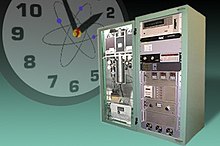Atomic clock


An atomic clock is a clock that works with atoms, as opposed to most other clocks which are mechanical. The frequency comes from the crossing radiation of electrons. Atomic clocks are currently the most exact clocks of the world. They are also called primary clocks.[1]
Most clocks know the time because they count how many times something moves back and forth. Atomic clocks count how many times an atom wiggles back and forth.
Worldwide, there are over 260 atomic clocks at over 60 different places. All data is collected at the International Bureau of Weights and Measures in Paris, France. The International Atomic Time is calculated there.[2]
The basics were developed by Isidor Isaac Rabi. He was an American physicist at Columbia University. He got the Nobel Prize in Physics in 1944.[3]
References
[change | change source]- ↑ "The primary clocks" (in German). Retrieved December 1, 2009.
- ↑ "BIPM". Retrieved December 1, 2009.
- ↑ Fritz von Osterhausen (1999). Callweys Uhrenlexikon. München: Callwey. p. 24. ISBN 978-3-7667-1353-7.